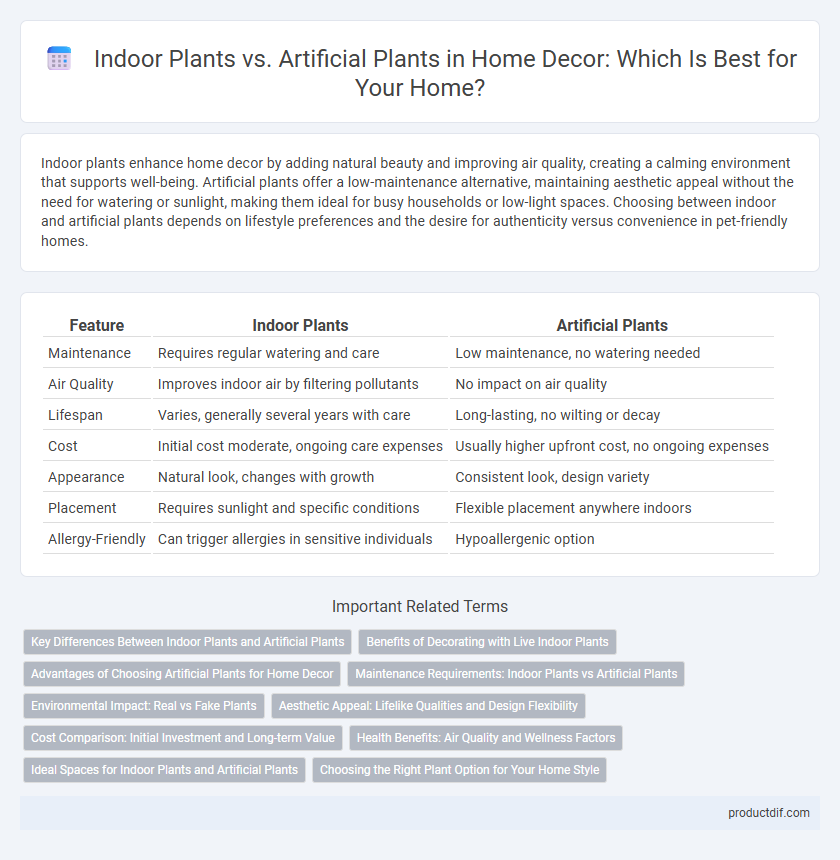Indoor plants enhance home decor by adding natural beauty and improving air quality, creating a calming environment that supports well-being. Artificial plants offer a low-maintenance alternative, maintaining aesthetic appeal without the need for watering or sunlight, making them ideal for busy households or low-light spaces. Choosing between indoor and artificial plants depends on lifestyle preferences and the desire for authenticity versus convenience in pet-friendly homes.
Table of Comparison
| Feature | Indoor Plants | Artificial Plants |
|---|---|---|
| Maintenance | Requires regular watering and care | Low maintenance, no watering needed |
| Air Quality | Improves indoor air by filtering pollutants | No impact on air quality |
| Lifespan | Varies, generally several years with care | Long-lasting, no wilting or decay |
| Cost | Initial cost moderate, ongoing care expenses | Usually higher upfront cost, no ongoing expenses |
| Appearance | Natural look, changes with growth | Consistent look, design variety |
| Placement | Requires sunlight and specific conditions | Flexible placement anywhere indoors |
| Allergy-Friendly | Can trigger allergies in sensitive individuals | Hypoallergenic option |
Key Differences Between Indoor Plants and Artificial Plants
Indoor plants improve air quality by absorbing carbon dioxide and releasing oxygen, while artificial plants require no maintenance or watering. Indoor plants vary seasonally and may face issues like pests and diseases, whereas artificial plants maintain a consistent appearance year-round. The choice between natural and artificial plants impacts ambiance, with live plants offering a dynamic, health-boosting environment and artificial plants providing long-lasting, allergy-free decoration.
Benefits of Decorating with Live Indoor Plants
Live indoor plants enhance air quality by absorbing toxins and releasing oxygen, creating a healthier living environment. Their natural textures and vibrant greenery boost mood and reduce stress, contributing to overall well-being. Unlike artificial plants, live greenery supports biodiversity and requires minimal maintenance, making them a sustainable decor choice.
Advantages of Choosing Artificial Plants for Home Decor
Artificial plants offer long-lasting beauty without the need for sunlight, water, or pruning, making them ideal for low-light or busy indoor environments. They provide allergy-friendly, maintenance-free greenery that remains vibrant year-round, enhancing any home decor scheme effortlessly. Modern artificial plants feature realistic textures and colors, creating visually appealing focal points that require minimal upkeep compared to live indoor plants.
Maintenance Requirements: Indoor Plants vs Artificial Plants
Indoor plants require regular watering, adequate sunlight, and occasional fertilization to thrive, making their maintenance more demanding and time-intensive. Artificial plants offer a low-maintenance alternative, needing only occasional dusting and no watering or light exposure. Choosing between indoor and artificial plants hinges on balancing desired aesthetics with the time commitment for upkeep.
Environmental Impact: Real vs Fake Plants
Indoor plants contribute to improving air quality by absorbing CO2 and releasing oxygen, supporting a healthier indoor environment. Artificial plants, while low-maintenance, are typically made from non-biodegradable materials like plastic, leading to environmental pollution and waste issues. Choosing real plants reduces carbon footprints and supports biodiversity, whereas fake plants increase landfill burden without providing ecological benefits.
Aesthetic Appeal: Lifelike Qualities and Design Flexibility
Indoor plants offer a natural aesthetic appeal with lifelike qualities including varied textures, colors, and organic growth patterns that enhance room ambiance. Artificial plants provide design flexibility by maintaining consistent appearance year-round without the need for maintenance, making them ideal for low-light or high-traffic areas. Both options contribute distinct visual elements, but real plants bring dynamic vibrancy while artificial ones offer customizable shapes and styles to fit specific decor themes.
Cost Comparison: Initial Investment and Long-term Value
Indoor plants require a moderate initial investment for quality pots, soil, and healthy plants, while artificial plants often have a higher upfront cost due to materials and realistic detailing. Over time, indoor plants offer long-term value by improving air quality and evolving aesthetically, whereas artificial plants have low maintenance costs but may need replacement to retain their appearance. Evaluating cost-effectiveness involves balancing the ongoing care expenses of living plants against the one-time purchase and durability of artificial options.
Health Benefits: Air Quality and Wellness Factors
Indoor plants improve air quality by absorbing carbon dioxide, releasing oxygen, and filtering toxins like formaldehyde and benzene, which enhances overall wellness and reduces respiratory issues. Artificial plants lack these air-purifying properties but require zero maintenance and do not trigger allergies, making them suitable for those sensitive to pollen and mold. Choosing real plants promotes a healthier indoor environment through natural air filtration and increased humidity, contributing to mental well-being and stress reduction.
Ideal Spaces for Indoor Plants and Artificial Plants
Indoor plants thrive in well-lit areas such as living rooms, kitchens, and offices where natural sunlight supports their growth and air purification benefits. Artificial plants are ideal for spaces with low light or high humidity, including bathrooms, basements, and windowless rooms, offering maintenance-free greenery without the risk of wilting. Choosing the right type depends on the space's lighting conditions and the desired level of upkeep.
Choosing the Right Plant Option for Your Home Style
Selecting indoor plants or artificial plants depends on your home style, maintenance preferences, and lighting conditions. Indoor plants enhance air quality and offer natural aesthetics but require consistent care, making them ideal for spaces with good natural light and time for upkeep. Artificial plants provide low-maintenance, long-lasting greenery suitable for low-light areas or busy lifestyles, seamlessly complementing modern or minimalistic decor.
Indoor plants vs Artificial plants Infographic

 productdif.com
productdif.com